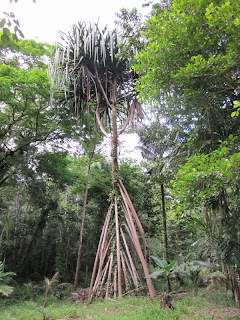http://apscience.org.au/projects/PBF_02_3/pbf_02_3.htm
It seems as if , maybe by chance , a hybrid occurred between 2 inedible Musa species , creating a plant with an edible fruit and this was spread by humans to South East Asia/India/China. Bananas are recorded in Buddhist texts from 600BC. Alexander the Great is attributed to having taken them to the Middle East and thus the Romans were familiar with them. Musa - the genus name - was a Roman physician who recommended this food to Augustus Caesar. In about 650AD, Arab traders took plants to Madagascar and Africa. From there, Portugese and Spanish sailors took plants to the Caribbean and the Americas in the 1500's. What an amazing historical journey for this plant. Whilst in PNG I would have liked to have seen wild banana plants but unfortunately this did not happen.
There is a very comprehensive Wiki on banana :
http://en.wikipedia.org/wiki/Banana
 | ||||
| Egum atoll - "sugar" banana bunch |
Pubmed search - not much, surprisingly. There was a couple of abstracts basically showing that green (cooking) bananas have resistant starch that acts like dietary fibre. Dietary fibre is useful in diabetic treatment - it improves control and one study ( abstract 28) did show over 4 weeks that diabetic patients given "native banana starch" had weight loss and reduced insulin production.
Here's a bunch of a variety called "lady finger" . There is a limited number of varieties back yard gardeners are allowed to grow in Queensland because of certain diseases. I have harvested it now to beat the flying foxes and possums - it will ripen over the next few days/week:
Whilst cutting the banana bunch - a process that involves cutting the whole banana "tree" down , I noticed this kingfisher sitting on the clothes line. It is called a Forest Kingfisher. The colour of this little bird is stunning. It does seem to be a seasonal bird and one web site I found mentioned the possibility of a migratory movement from PNG to SE Queensland:
http://birdsinbackyards.net/species/Todiramphus-macleayii
No posts for a few days - Anne and I are off to see Lake Eyre whilst it has water!
Tom
































